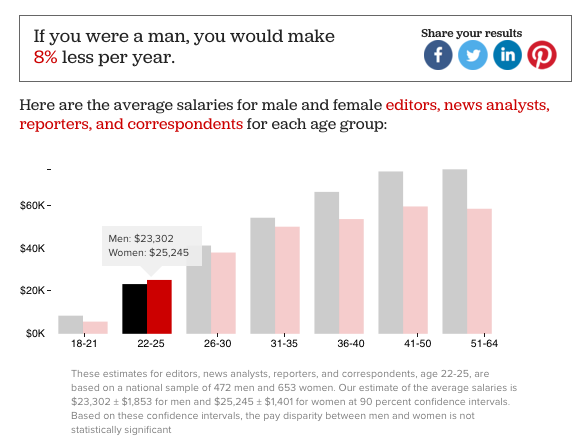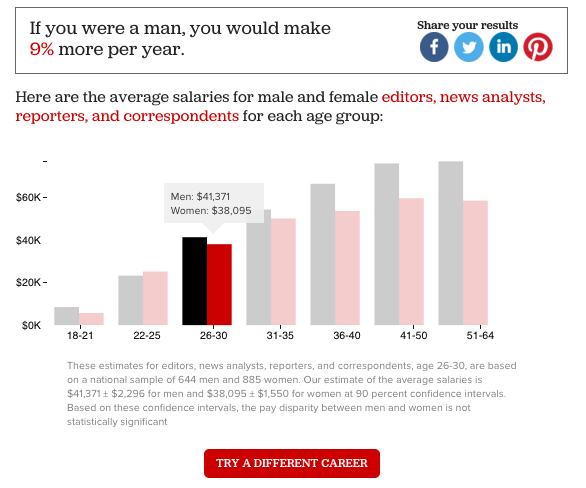This Quiz Shows How Much More You Would Make If You Were a Man

By:
In 2009, President Obama passed the Lilly Ledbetter Fair Pay Act, advocating for equal pay for women and distinguishing unequal paychecks as individual violations of law. Since the act was passed, numerous high profile Hollywood actresses have spoken out about unequal pay and demanded salaries that matched those of their male costars. However, the gender pay gap's effect on women outside of the public sphere is less discussed.
The gender pay gap persists and impacts women in industries from science and technology to public relations. Time and Motto recently published a comprehensive analysis on wage inequality including a quiz that determines the pay gap you are most likely to face based on your age and occupation.
Counter intuitively, a 24-year-old female journalist such as myself is likely to receive an 8 percent higher salary than a male journalist of the same age.
 Time/motto - time.com
Time/motto - time.com
The gap remains 8 percent in favor of women at 25 and crosses over — with men making more — at age 26. (Of course, at ATTN:, male and female reporters are paid equally.)
 Motto/Time - time.com
Motto/Time - time.com
The gap begins to widen more dramatically in the mid-30s, jumping from 8 percent to 24 percent between ages 35 and 36.
This is similar to patterns identified among teachers, librarians, social workers, secretaries, and preschool teachers. In female-dominated professions, the pay gap comes in later in your career, in terms of promotions. Time reports:
"There is research to show that in female-dominated professions, men get promoted more quickly than women do in their field, an effect that has been termed the “glass escalator.” Male and female registered nurses, our research shows, make roughly the same pay in the youngest cohorts, only to have a significant wage gap open up in their 30s and beyond.
"Looking at the earning patterns for secondary-school teachers helps tell this story. From ages 22-25, women actually earn 10% more than their male colleagues. By the time those teachers turn 30, there is no statistical difference between them and their male peers. By 35, the men make more. It’s a pattern we see repeated with librarians, social workers, secretaries and preschool teachers. Notably, these are all female-dominated professions. In male-dominated professions like engineering and finance, women typically make less from the very start."
The survey suggests that pay discrimination happens most during promotion season in female-dominated professions, while it comes into play during hiring in male dominated fields like science and tech. A 2012 double-blind study found that a male lab tech candidate was offered a higher starting salary than a female applicant with an identical resume.
 Flickr/rdecom - staticflickr.com
Flickr/rdecom - staticflickr.com
President Obama is now revisiting the issue of equal pay, and has proposed making federal data about employee pay more publicly available. You can see how the pay gap effects you by taking the quiz on Time/Motto.
